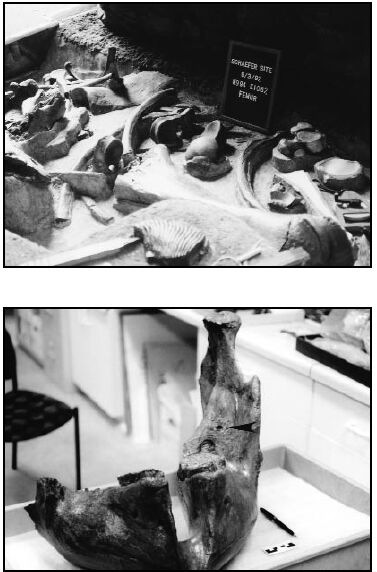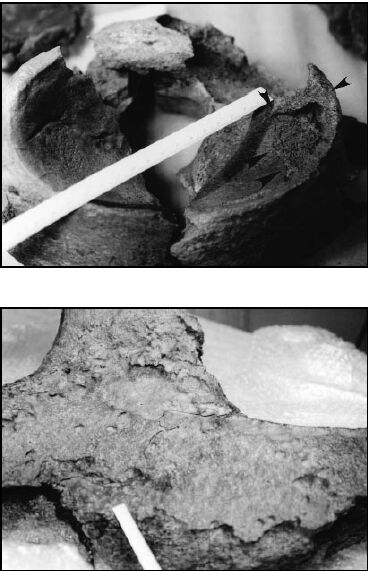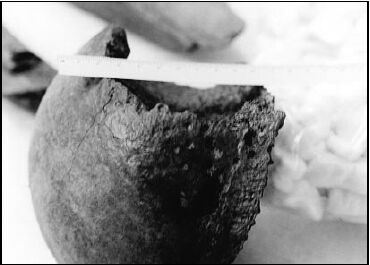|
Part One
The Schaefer Mammoth
|
E.J. Neiburger and Dan Joyce
|
| Central States Archaeological Societies 2004
January Journal |
Waukegan, Illinois
|
12,300 years ago
The man stooped behind a bush to keep from being sighted. He stripped down to his breech cloth
and smeared mammoth dung on his body. He had been waiting for the right moment for hours. Several other men were
100 yards away, working hard not to be seen by the grazing mammoth. Cover was scarce and stunted by the cold weather.
The mammoth was huge. It stood more than two men high and had tusks over nine feet long. It was a lone male grazing
under the clear sky filled with billowing clouds. It was a warm July day, about 60 degrees. Soon the lone man had
finished covering himself with dung so as not to be scented when he moved closer to the mammoth. The wind was in
his face and blowing from the mammoth to him. That was good.

He cleaned off his hands so he could get a better grip on the spear. The spear was not a simple weapon. It had
a separate foreshaft, about eight inches long that firmly held a finely crafted point of stone with razor sharp
edges. When he finished his preparation and the mammoth was finally in the right position, he silently signaled
the others. They then sprang up and ran in front of the mammoth making just the right amount of noise and movement
to keep the mammoth’s attention. Too much noise and the mammoth would run away or worse, charge. Too little noise
and movement and the mammoth would ignore them. At his size he had only two predators to worry about the dire wolf
and the newcomer to his world that he had little or no experience with: man.
The lone man’s muscles tensed and his heart raced as his friends got the attention of the mammoth. He began to
silently and swiftly run towards the mammoth, his moccassins making little noise on the patches of tundra and grass.
He ran between stunted black spruce that were already 200 years old but had trunks only a few inches in diameter.
He ran towards the mammoth from behind and a little off to the side, the wind in his face. With the addition of
mammoth dung on his body and the wind in his face, the mammoth would not be able to scent him. The mammoth’s attention
was focused in front of him on these strange creatures making noise and gesturing. The lone man ran faster and
faster, making little noise as the wind pushed the tips of the grass back and forth. The short spear in his hand
was at the ready. He oriented the point so its cross section was up and down. That made it easier to slide between
the long hair hanging from the animal.
Soon he was nearing the animal. As he neared it, the others got closer to the front of the mammoth and made more
noise, fixing his full attention on them. They were a little to the left of the front of the animal. The lone man,
running full force, ran under the mammoth just in front of his rear legs. Without breaking stride or stopping,
he thrust the spear into the gut of the mammoth and kept running beyond the animal, getting as far away as fast
as he could.
The mammoth’s first reaction was to rear up on his rear legs, letting out a horrendous trumpet. He then turned
his head to the left, trying to see why there was such a burning pain in his left side. At the same time the lone
man was well on his way to safety, running past the right side of the mammoth. The foreshaft of the spear was firmly
in his intestines through the thinnest part of the hide. The other men had instantly dispersed so as not to be
trampled, their job finished. The single wound would be fatal. There was no need to thrust spears into him several
times. Gut wounds were always fatal and a slow way to die. The men now had only to wait.
They followed the wounded animal at a safe distance. They could tell that it was getting weaker as it bled and
developed a high temperature. As his temperature increased, the mammoth went to the nearest standing water and
stood in the water to cool down. Within two days he was dead and the long process of butchering began. The feast
was a windfall.
1964
It was a cool day in September of 1964. The crop was out of the field, and the tiling machine
was hard at work. The field lay between two north-south trending ridges with a ditch at the lowest point. In between
was rich, organic soil that was often too wet to run equipment through. The tiling machine and its operator were
called in to help drain some of the field by cutting ditches across it and laying drain tiles down to the ditch.

As the machine slowly made its way up the western incline, it easily tossed rocks aside, cutting an 18 inch wide
ditch into the field. Suddenly, the machine hit something big and jolted to a halt. The operator was thrown from
the machine. This had never happened before. Examining the area where the stoppage occurred, Mr. Schaefer, his
son and the operator noticed a large end of a bone in the dirt. They could see that it looked like a knuckle, but
it was huge. The diameter of the shaft was six inches and the end was eight inches.
That night Mr. Schaefer called Phil Sander, a local avocational archaeologist/naturalist. Phil came out the next
day to examine the bones and the site. The bone definitely belonged to either a mammoth or mastodon. Phil thought
it might be the end of a humerus but it later turned out to be the end of the femur or thigh bone.
At the site of the find, the ditch had been filled in by the time Phil got there, but in closely examining the
disturbed soil Phil found fragments of ivory. With a bit of help, Phil managed to make a sketch map with several
landmarks, bearings and distances for his notebook. Mr. Schaefer gave the bones to Phil, and Phil later donated
them to the Kenosha Public Museum. Soon they formed a part of an Ice Age mammal exhibit case featuring the Schaefer
bone, two mastodon teeth found in the area and many Alaskan mammoth, bison, horse and camel bones that had been
donated the year before. Looked at by tens of thousands of visitors, they sat in the exhibit case for the next
twenty-eight years.
1990
Late November of 1990 marked a turning point for the museum, mammoths and the staff, although
none of us realized it at the time. Dave Wasion came into Dan Joyce’s office at the Kenosha Public Museum and said
that he was at the other museum in town examining some mammoth bones when he noticed butchering marks on the bones.
This was exciting news. If it were true then we finally had a mammoth butchering site east of the Mississippi River.
A few days later the bones were examined by Joyce, Wasion and Dave Overstreet, and all agreed that they looked
like butchering marks made by stone tools. Joyce had worked at the Blackwater Draw Museum in New Mexico (the original
Clovis site) years ago and knew what real Paleo Indian butchering marks looked like. These mammoth/mastodon bones
were from two different sites in Kenosha County – Fenske and Mud Lake. The first was discovered during ditching
activities by the Chicago and Northwestern Railroad in 1919 and the second by a Works Progress Administration crew
ditching at Mud Lake in 1936. Two butchered mammoths in the county! Their hearts were pounding and minds racing.
Joyce began to think about the Schaefer find. During all those years in the exhibit case, no one had ever thought
to look closely at the bone. Joyce took the bone from its case and examined it closely. There were no definitive
marks like the bones from the other sites, but there were some suspicious marks. This made for a total of two butchered
Ice Age animals in the county and possibly one more. Only about two dozen butchered mammoths had been found in
all of North America during the past sixty years, and now we had two and maybe even three more.
Now it was time for Joyce and Wasion to do some digging, but not into the dirt. Local newspapers were combed to
find out more about the Mud Lake and Fenske discoveries. People in the area were interviewed, and this led to more
people. Soon we had a fairly good idea of where the animals were originally found. It was at this point that we
found Phil Sander and his map. It was like a treasure map, but instead of an “X” marking the spot, there was a
star. This was the best information on where any of the three sites were located.

1992
With a small grant from the state archaeologist’s office in hand, we started work at the beginning
of August. The first day was auspicious. They started by using Phil’s map and the nearest landmark on his map,
a fence post. They determined an area of the field where the mammoth/mastodon could be found. With an industrial
weed whacker, soy beans were cleared from an area about forty feet on a side. The first 2 by 2 meter test pit yielded
nothing. Not too surprising, considering that looking for a mammoth in a 300 acre field was like looking for a
needle in a hay stack. But the ace up their sleeve was the map. Talking to Frank Schaefer, the son who was there
when the mammoth was found and who now owned the farm, they found out that their fence post landmark had been moved
twenty feet since 1964. It was time to re-measure and re-calculate.
By the third day, the second test pit yielded a navicular or rear foot bone of a mammoth. There was no doubt about
it, they were in the right place. Soon the excavation expanded outward to encompass a number of pits. By November
an area about twenty-four by thirty feet had been excavated down to an average of about two and one-half feet.
They now had a large pile of disarticulated bones,with some bones here and there outside of the pile. By early
November it was time to close the site. The outlying bones were removed and insulated walls built around the bone
pile. Outside of the walls,the site was backfilled. An insulated, flat roof was built and dirt piled over for insulation.
This is how the site spent the winter of 1992/1993.
1993
In late June, the dig was opened up again and the bone pile excavated. Bone after bone was discovered
as the layers were uncovered. The twisted mass lay just as they had been thrown so many years ago. The previous
year all of the sediments had been screened, but no stone tools had been found in the screen or in place during
excavation. Near the end of the excavation two stone tools had been found under and in contact with the pelvis.
They were not much – a crest blade and a small blade – but they were definitely human made. Now they had the smoking
gun. For so long they had looked at a human-made bone pile, human breakage, cut marks and now tools. The excavation
was completed in August of 1993. Now it was time for the long process of analysis.

1993-2003
Getting a mammoth out of the ground in a proper way is the easy part. Then comes years of work
on the analysis. Research on the geology of the site and the area began during the excavation and continues into
2003. Understanding the site and its setting is imperative to knowing what the environment was like, how the site
was formed and how it has been effected in the last 12,000 years.
Analysis of pollen samples taken from the mammoth bones indicates that the mammoth lived in an open spruce forest
with tundra openings. Wood recovered from the bone pile is spruce, as is a number of cones recovered which are
black spruce. Analysis of what has happened to the bones in the last 12,000 years has also been completed. The
marks interpreted as cut marks by Joyce are indeed cut marks. Limited trampling and carnivore marks are also present.
The bone pile had not been disturbed since it was deposited.
Multiple lines of evidence show that the animal was a male and was 36 (African) elephant – equivalent years old
at death. Further analysis is underway to determine what species the Schaefer mammoth is – primigeneus (woolly)
or jeffersoni (Jefferson).
Amino Acid racemization analysis has been undertaken. Amino acid is well preserved in two of five samples submitted.
Generally, if the amino acids are well preserved, the DNA is usually well preserved as well. No, this isn’t for
cloning purposes, but to further the knowledge of the genetic line of mammoths and how it relates to modern elephants.
DNA work will continue in 2004.
The lithics from the site were analyzed. They are definitely human made and do not show any use wear. The edge
of one blade was abraded during manufacture. The larger of the two blades is 37mm long and is a crest blade. A
crest blade is the first blade to be removed when creating a blade core.

The most important and interesting study to date is radiocarbon dating of both associated wood and of the bone
itself. There are now 16 dates on spruce associated with the bones and often even in contact with them. Dates range
from 11,980 70 (BETA 175191) to 12,940 70 (BETA 173273). Thirteen highly purified collagen AMS dates have been
run to date. These dates range from 12,290 60 (CAMS 72140) to 12,570 45 (CAMS 95521). This suite of dates firmly
places the Schaefer mammoth site as being as much as 1000 years older than Clovis mammoth sites in the Western
United States. Although the research continues, one of the last analyses being performed is the paleopathology
of the Schaefer mammoth.
End of Part One
|




